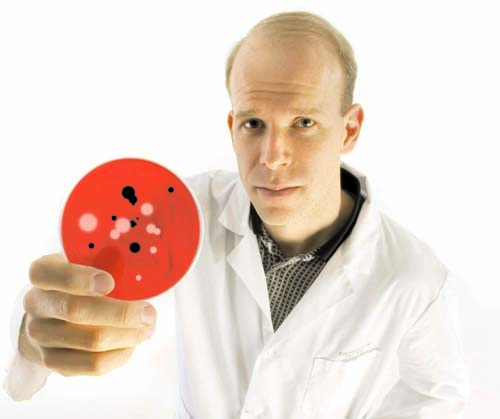
Pathobiology professor Scott Weese says that to understand the abnormal, you have to know what’s normal. And normal, for mammals, is to have more than 10 times as many bacterial cells in and on our bodies as our own cells.
We can’t live without these bacteria, but when they become altered in some way because of illness, diet, medication or other factors, a range of problems can occur. In humans, altered gut flora — bacteria living in the stomach and intestines — can be linked to inflammation, allergies, obesity, difficulties with brain function, inflammatory bowel disease, metabolic disease, cancer and other problems.
“It’s not just one bug that causes these problems, it’s how the whole population of bacteria in the system interacts and balances,” Weese explains.
“Largely because of the complexity of these bacterial populations and technological limitations, only recently have we had the tools to properly explore these ecosystems. Our knowledge of the canine microbiota is currently limited,” he adds, “but knowing what’s normally present in the dog’s system is critical for diagnosing illness. Our research is studying what bacteria are present in different body sites in healthy dogs and exploring how that varies among dogs of different ages and different environments, and in sick versus healthy dogs.”
Weese and his co-researchers are looking at bacteria in dogs’ guts, on their skin, in their mouths and in their nasal cavities. So what lurks inside your dog’s mouth? He says that every dog seems to carry multiple zoonotic bacteria, which can also infect humans. “There is always some degree of risk in being exposed to those germs,” he says, but actually getting an infection is rare.
For some people, though, a little dog saliva can be extremely dangerous. On his popular Worms and Germs blog, Weese mentions a case that made headlines recently: an Ottawa woman lost three limbs to an infection caused by Capnocytophaga canimorsus. This bacterium is found in the mouths of almost all dogs, Weese explains, but it is generally only dangerous to someone without a spleen, who has a compromised immune system, or who is an alcoholic. If you fit into one of those groups, he adds, speak with your doctor about the risk from this bacterium and avoid contact with a dog’s saliva.
Of the hundreds of types of bacteria found in every dog’s mouth, many have not been identified. Those unknown bacteria are ones that don’t grow in cultures, an older method of finding bacteria. Instead, Weese uses bacterial DNA to distinguish the different types, giving a more accurate picture of the multitude of germs that are present.
His research studies are also looking at how bacteria change over time, which can vary from one species to another, Weese says. The gut flora in horses, for example, tends to become very complex quite quickly. In dogs, their gut flora develops more gradually
Early exposure to bacteria also seems to be a key factor; Weese says that the flora of a dog being raised on a farm may be quite different than that of a dog raised in a city apartment. “Even if we brought both dogs to the same home after three months, the bacteria in their systems might never be the same. We’re only starting to comprehend the different factors that influence our microbial populations.”
Another project is investigating stool transplants for dogs with chronic diarrhea. “The idea is that some diseases are the result of disruption of the normal bacterial population, and restoring that population is the key to cure,” says Weese. “If we can restore the gut flora to a normal state, we may be able to cure the disease.” Dogs are probably less squeamish about stool transplants than people.
Studying the canine biome is a new field, Weese explains. “It seems like every study we do leads to more questions.” There appears to be significant variation among dogs. Weese says that the precise composition of the bacterial flora in any part of a dog is probably multi-factorial. “We don’t know yet if the breed of the dog makes a difference, although we do know that some illnesses are more common in some breeds than in others, so perhaps it is a factor.”